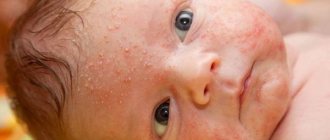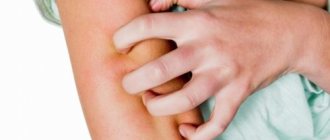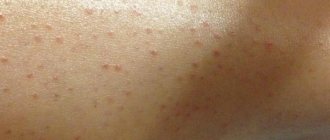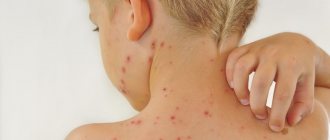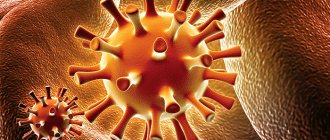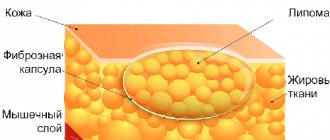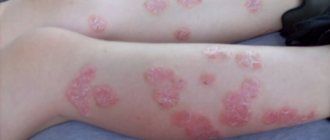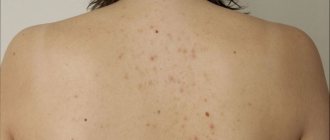Each of us has experienced acne on our body at least once in our lives for one reason or another. They could be on the head, cheeks, forehead, arms and stomach. Sometimes these growths may not be ordinary pimples, but an actual rash. As a rule, it covers certain areas of the body. If you notice, for example, a rash on your legs, then the information below will be useful for you. To fix a problem, you need to know the cause of its occurrence. So let's find out why such an unpleasant symptom could appear on your lower limbs.
Causes of rash on legs
There are not many reasons for the appearance of this symptom, but all are unpleasant in their own way. Below are the most common reasons that cause rash on the legs:
1. Allergy
. It appears due to contact of the skin with an allergen substance. Pimples in this situation are pink, small and protrude above the skin level. If you do not stop the action of the allergen, they can turn into small bubbles with liquid inside, begin to peel off and be accompanied by an uncontrollable desire to scratch the whole thing on your legs. So, watch your lifestyle and identify the offender of your skin as quickly as possible. And in the future, if you cannot eliminate the irritant, then take antihistamines and sedatives. And don’t forget to contact a specialist who will select the most effective medicine for you in the fight against allergies.
2. Scabies
. One of the symptoms was, is and will be itching. In addition to everything, you will have all sorts of blisters, spots and bumps on your feet. The doctor must prescribe medications that contain ascaricidal substances.
3. All kinds of diseases
. The most striking representative of this group is infective endocarditis. It is this that causes a bright red rash on the legs with a painful effect. But such a symptom can disappear instantly, thereby freeing you from any suspicion of a serious illness. In this case, you should contact a vascular surgeon, who will explain to you that the pathology may be in the veins.
4. Fungal infections
. It’s simple: somewhere they didn’t take care of the hygiene of their lower extremities.
What to do if a rash appears on your legs
If you notice such a symptom in yourself, do not go to work, covering your illness with a long skirt or trousers. Run to see a doctor. Only after a detailed examination by a highly qualified specialist and several necessary tests will you find out the cause of the inconvenience. Try to tell the dermatologist as much as possible about your problem, for example, when it started, that the rash on your legs itches, hurts, oozes, and so on.
Such facts will help to more accurately and quickly determine the true culprit of the rash. Once the diagnosis is established, you will be prescribed a course of treatment. If you have been referred to an infectious disease specialist or allergist, do not worry. Simply, a dermatologist, having established the cause of the rash, sends you to other specialists who practice similar treatment. For example: if your rash is not associated with any infections or skin diseases, then you need to go to an allergist who can help identify the irritating allergen. Take care of your health and for serious issues, do not forget to consult your doctors.
The skin has a number of biochemical and physiological characteristics. A small rash on the legs appears for various reasons in almost every person. The appearance of this disease in adults can be either a common allergic reaction or one of the symptoms of a serious illness. Unfortunately, in most cases it is impossible to independently determine the nature of the rash, so if you notice signs of unhealthy skin, you should immediately consult a doctor for professional help, which will help you get rid of the health problems that have arisen as quickly as possible.
What to do in case of such manifestations?
You can treat allergies yourself only if you know exactly the cause of the irritation.
Otherwise, the consequences may be unpredictable. You can also self-medicate for a fungal infection, however, it should occur in complete isolation.
If a red rash appears on the legs, this may indicate serious health problems. Such symptoms are characteristic of a wide range of diseases, which makes it difficult to draw specific conclusions without a professional medical examination. The most harmless cause of skin irritation is insufficient attention to personal hygiene. Also quite common causes of this symptom can be the consequences of an insect bite, or a banal allergic reaction. To find out for sure, the best solution would be to visit a dermatologist, since only he is competent to make an accurate diagnosis and prescribe the most effective treatment.
You need to prepare for a visit to the hospital, since the doctor may be interested in the following questions to determine the causes of the rash:
- are there any changes in general physical condition?;
- Has your body temperature risen recently?;
- is there any pain in the areas of the rash?;
- What measures were taken after the rash was discovered?
It is extremely important to determine the presence of infectious or inflammatory processes in the body as quickly as possible. To do this, your doctor may require you to do a series of tests. If tests do not confirm the presence of infection, then there is no cause for serious concern.
Causes of a rash on the legs in the form of red dots
The reasons that provoke the appearance of small rashes on the legs can be divided into:
- external mechanical influence;
- diseases of internal organs;
- allergic reactions;
- infectious and non-infectious skin problems.
External reasons
Let's look at the reasons why a rash may occur on the legs of both an adult and a child. It should be noted that the rash may or may not be accompanied by itching.
Insect bite . In this case, the rash on the legs is the body’s reaction to the bite of an insect. It is worth noting that a person may not always notice that he has “been attacked.” Of course, a person feels a mosquito bite immediately, but a bug bite or some kind of midges can only make itself felt after some time. The affected area of the skin begins to itch, which causes concern, especially in children. Babies constantly scratch their skin, and this can cause an additional problem - infection.
In the photo you can see what numerous mosquito bites look like.
Skin irritation . This problem, first of all, concerns the fair sex, who cannot do without the depilation procedure. And since it is carried out quite often in the summer, the skin cannot withstand such external influences and reacts by the appearance of red dots on the legs.
Cloth . If wardrobe items are made of dense fabric that does not allow or does not allow air to pass through well, then the skin of the legs may react with small itchy rashes in the form of red dots.
Prolonged exposure to the sun . Rashes after spending a long time in direct sunlight most often occur in people with pale skin. The sun's rays cause redness and rashes that affect not only the legs, but also other parts of the body (see photo).
Stress and nervous tension . The rash appears after experiencing stressful and nervous situations. Often the rashes are itchy, which causes additional discomfort. After the nervous system comes into balance, the rash disappears. If a person quite often develops a rash after excitement, stress, or anxiety, it is necessary to contact a neurologist so that he can prescribe medications to normalize the state of the nervous system.
Weakening of the body's defenses . If a rash appears in an adult, the cause may be a decrease in immunity. Why does the immune system fail? As a result of eating unhealthy foods, inadequate rest, or disruption of the digestive system.
Infectious and non-infectious skin diseases
With some skin diseases, one of the symptoms is a small rash that appears on both the legs and arms, as well as on other parts of the body.
Psoriasis is a dermatological disease that has become increasingly common in recent years. Accompanied by an itchy rash.
In the photo there is psoriasis on the knees.
Mycosis, or fungal infection , is a skin disease, the symptom of which is a rash on the legs, most often on the feet. It should be remembered that mycosis is a contagious disease. That is why, in order to prevent its spread among loved ones, it is necessary to immediately contact a specialist and begin treatment, as well as follow preventive measures. A patient with mycosis must adhere to the following rules:
- do not walk in the living area without shoes;
- It is strictly forbidden to use someone else's shoes or house slippers;
- You should only use your own towel.
Scabies . Rashes with this disease are always accompanied by severe itching, which intensifies at night, as well as after taking a hot shower.
Health- and life-threatening causes of leg rashes
Let's consider diseases that require mandatory consultation with a doctor, and sometimes treatment in a hospital, as they can pose a threat to the health and life of the patient.
Thrombophlebitis . Refers to diseases of the circulatory system of the legs. In addition to the rashes, which are mainly located around the blood vessels and are very itchy, thrombophlebitis has a number of characteristic signs. Among them are inflammation of the veins, their clear blue pattern and unnatural hardness. The disease becomes life-threatening at the last stage, when a blood clot breaks off, which can enter the vessels of the lung and cause death.
The photo shows the disease thrombophlebitis.
Diabetes . Rashes and itchy skin are common symptoms of diabetes. Not only your legs itch, but your whole body, which can become covered with both small rashes and blisters. The disease must be treated comprehensively, and in order to remove a separate manifestation - itching, the doctor prescribes medications for local relief of itching.
Allergic purpura . Attention! This condition requires immediate hospitalization of the patient, and no attempts should be made to eliminate the itching or fight the rash on your own. The disease develops more often in women than in men. However, children aged 3 to 7 years are most at risk. The rash in this disease develops as a result of an inflammatory process in the cells that line the vessels that deliver blood. In this case, not only the skin is affected, but also the digestive tract, joints, and urinary tract.
If adequate therapy is not carried out, allergic purpura becomes persistent, a person’s well-being deteriorates sharply, and life-threatening kidney disease may develop. The duration of an attack of allergic purpura is up to several weeks, after which death can occur. If the patient receives the correct treatment, then most people recover.
The photo shows allergic purpura.
Inflammation of the capillaries . Quite often, rashes on the legs without itching, as well as itching ones, are the result of an inflammatory process in the capillaries. At first, a small, unnoticeable rash appears, but if treatment is not started immediately, the rash quickly spreads to the entire surface of the legs. The main feature of the disease is the absence of a rash in the foot area.
Allergic reactions
There are many reasons why an allergic rash on the legs occurs. Let's look at the most common ones.
Cosmetics, detergents and laundry products . To eliminate the rash and itching, it is necessary, first of all, to remove the listed allergens.
Close communication with pets . Wool, fluff, feathers, saliva, dander from animals and birds can cause an allergic reaction in the owner in the form of a small rash on the legs. To get rid of allergies and not be separated from your family pets, you need to thoroughly ventilate the room, use an air filter, do wet cleaning more often, and keep animals out of the room where the owner sleeps.
Dust mites . Their favorite place is the bed, pillows, soft toys, sheets, blankets. It is the presence of dust mites that causes a very itchy rash in a person, which is located mainly on the knees and heels. The best solution would be to change down bedding to synthetic ones. A special insect control spray can also come to the rescue.
Food . Perhaps the body cannot tolerate certain foods. For example, chocolate, citrus fruits, red berries and fruits. In this case, it is necessary to consult an allergist and exclude foods that are harmful to health from the diet.
Urticaria . Occurs as a result of the use of certain medications or foods. The main symptom of the disease is a rash on the legs and other parts of the body that appears suddenly. The skin becomes red and swollen, and round blisters appear. They have a bright rim and a light center, ranging in size from small bubbles to large blisters. If the allergic reaction is severe, the blisters may coalesce into large spots. The appearance of blisters causes severe itching. In the photo you can see what the rash looks like with urticaria.
Types of skin rashes
There are several types of rash manifestations:
- 1. spots - rashes that do not protrude above the level of the skin;
- 2. blisters - unlike spots, protrude above the skin and have watery contents;
- 3. papules - their appearance resembles nodes, which are a benign neoplasm;
- 4. blisters - transparent new growths on the skin with liquid contents. In advanced cases, they begin to fester;
- 5. erythema - many red spots on the skin of a lumpy nature. This symptom indicates an allergic reaction to food;
- 6. ulcers and erosions - mainly appear as a result of damage to the upper layers of the skin of a traumatic nature;
- 7. crusts - sometimes appear at the site of the rash, which indicates the beginning of recovery.
Possible complications and prevention
The entry of an allergen into a healthy body changes its functions and causes a kind of restructuring with the development of hypersensitivity. In the case of a primary acute process, allergies can be quickly extinguished with medications. The person may never face a similar situation again. When the allergen acts constantly, even in small quantities, the body’s protective properties weaken, and allergic reactions appear again. Complications include:
- Bacterial, fungal infections of the skin. A weakened body is very sensitive to the action of pathological factors. Infectious agents easily affect a person with allergies.
- Scars. Advanced cases lead to the formation of skin defects.
- Anaphylactic shock. Symptoms (low blood pressure, thready pulse, pale skin and profuse sweating) require an immediate call to the ambulance. Anaphylactic shock without adequate treatment can result in death.
Preventive actions:
- If you are allergic to food, limit your intake of such food.
- After a shower or bath, be sure to dry the area between your fingers. The fungus loves high humidity.
- Shoes should be soft, comfortable, and fit.
- At night, lubricate your feet with baby cream. It will remove and prevent inflammation and itching.
- Wear pants, socks, and tights made of natural material.
- Change your socks and insoles regularly.
- Fight the problem of dry skin. Lubricate your feet with creams containing vitamin E.
- Clean your apartment more often and wipe off dust regularly.
Common Causes
Prickly heat
Quite often, a rash on the arms and legs appears due to prickly heat in warmer seasons. To prevent this disease, it is necessary to dress according to the weather so that the body sweats as little as possible. In addition, when choosing clothes you should not skimp, since cheap fabrics do not allow the pores to fully “breathe”.
- 1. cold (formed in some cases during prolonged exposure to the cold);
- 2. mechanical (manifested due to frequent changes in blood pressure);
- 3. contact (transmitted through physical contact).
Infection
The infectious nature of the rash can be determined independently by the characteristic symptoms. As a rule, this is dizziness, nausea, fever to febrile or subfebrile levels. Not all symptoms may appear, but if you have at least one, you should call a doctor at home as soon as possible. In this case, you should not visit a medical facility on your own, since the infection can easily spread through airborne droplets. You should know that it is better not to treat the rash with anything, as this will complicate the process of determining the diagnosis. In most cases, such ailments can be successfully treated at home, however, in especially severe cases, a hospital stay is required.
A rash in the groin area is common. The nature of such a rash is slightly different from other types of this disease. This is often caused by uncomfortable clothing, which constantly rubs the private parts. The cause may also be a lack of personal hygiene or too sensitive skin in a given part of the body. You should try replacing regular soap with a softer one that will not cause irritation.
Other etiological factors
Overweight people have a problem with rubbing the inner thighs. In obese people, the legs rub against each other a lot, which often leads to bleeding. In such situations, pantaloons come to the rescue and should be worn instead of standard underwear. This kind of skin damage should be constantly treated with antiseptic agents, since there is a risk of infection under the skin, which will be very difficult to cure in the future. To avoid this, the best solution is to exercise and achieve an acceptable weight.
Fungal infection
If a rash on the feet begins to bother you, then you can suspect a fungal infection, in which the foot begins to create discomfort. The disease is extremely unpleasant because it takes a long time and is difficult to treat, and is also extremely easily transmitted. Simply walking barefoot on the floor is enough to infect your roommates, so treatment should be started as early as possible. But before making sudden conclusions, you need to see a doctor. He will determine the nature of the rash and prescribe the most effective treatment. Fortunately, modern pharmacies have a huge range of drugs that can successfully treat foot fungus. Before taking it, you should definitely check the dosage with your doctor.
When found on the skin of the legs
fungus, you need to treat the entire living space with bleach as quickly as possible and make sure that each family member has personal hygiene items. Otherwise, there is a huge risk of infecting the entire family, including young children.
You need to think carefully about what caused the fungal infection. As a rule, this is a visit to a bathhouse, public shower and other similar establishments without special shoes. It is necessary to remember that you should only appear in these establishments in your own rubber slippers. During the period of treatment of the fungus, you should definitely forget about swimming in a public pool or going on a beach holiday, since the infection will in any case spread to others.
Itchy symptoms
The rash on the legs itches and this is an absolutely normal skin reaction to an irritant. There is no need to panic about this. In addition to itching, other unpleasant sensations may appear over time, and this is also nothing to worry about. The fungal infection itself does not pose a particular threat to human life and health. The only thing that confuses me is that it is very easily transmitted.
Itchy fungus on the toes deserves special attention. The itchy symptom can be eradicated within a week, but the infection itself will be less affected. Bacteria that provoke the development of fungus can live in the human body for years and gradually destroy the skin and nails. It is a mistake to believe that if an infected limb stops itching, then everything will go away soon. This is nothing more than a myth. In order to completely get rid of them, medical care and regular monitoring are necessary.
Treatment methods
If you do not want to visit a doctor, then treatment of a rash on the legs, unlike other skin problems, can be started independently using pharmaceutical products, namely: ointments, creams and other external agents. You should avoid taking medications internally as this may lead to health problems. Before using them, it is better to obtain qualified advice from a specialist. You can use traditional medicine, although the result rarely lives up to expectations, but among them you can find effective methods of influencing the rash. For example: baking soda solution relieves itching well.
If redness or rashes on the skin provoke pain, then you should definitely visit the office of a vascular surgeon, since thrombophlebitis and acute venous thrombosis have similar symptoms. In this case, treatment should be prescribed exclusively by a doctor. In addition, you need to wash your feet with a washcloth and soap as often as possible.
The appearance of a rash is a fairly common occurrence that everyone has encountered at least once. After discovering this skin disease, it is important to remain calm and try to determine the cause of its occurrence. If this is difficult, then do not put off visiting a dermatologist and follow all the recommendations. If the nature of the rash does not raise any questions, then you can begin self-treatment with external agents. It is better to refrain from the decision to take pills. For this there must be a basis in the form of test results and a doctor’s prescription.
And a little about secrets...
Have you ever had problems with Dermatitis or ringworm?
? Judging by the fact that you are reading this article, you have a lot of experience. And of course you know firsthand what it is:
- scratch irritation
- wake up in the morning with another itchy plaque in a new place
- constant unbearable itching
- severe dietary restrictions, diets
- inflamed, bumpy skin, spots….
Now answer the question: Are you satisfied with this? Is it possible to endure? How much money have you already wasted on ineffective treatment? That's right - it's time to end them! Do you agree? That is why we decided to publish an interview with Elena Malysheva, in which she reveals in detail the secret of where these problems come from and how to solve them. Read the article...
The skin is constantly exposed to external influences, including infectious ones. On the other hand, the skin is closely related to the work of internal organs, which is also a factor in damage to the skin in their pathologies. Therefore, there are many reasons for the appearance of various skin rashes - infectious diseases, allergies, blood and vascular diseases, as well as insufficient hygiene.
Types of rash
There are a variety of skin rashes, but they can all be divided into two types:
- Primary . They appear on healthy areas of the skin or on mucous membranes due to a pathological process.
- Secondary . Such rashes form in areas that are already damaged by other skin diseases. Their appearance is associated with the influence of unfavorable factors or incorrect actions (lack of treatment of the primary disease, reintroduction of infection into the wound, etc.).
This division of the rash is associated with the reasons for its formation. But types of rashes are also distinguished according to their characteristics - appearance, size, location, degree of danger and other characteristics.
The most common are:
- Spots . They are areas of the skin that differ in color. May have different shades and sizes. Spots appear due to diseases (for example, dermatitis). Sometimes they can be permanently present on the body - moles. These also include freckles. The spots do not have specific localization sites; they can be located on any part of the body.
- Bubbles . They are small in size (2-6 mm). Such formations are located deep in the skin. They contain watery or bloody fluid. The cause of this type of rash is usually an illness (herpes or dermatitis). It could also be a manifestation of an allergy.
- Blister. This type of rash has the appearance of swollen redness. Blisters on the skin can come in different sizes and shapes. They occur for various reasons and usually do not require treatment.
- Pustule . This is a small formation in which pus accumulates. Pustules can be located deep in the skin or on its surface. They usually appear due to the penetration of bacteria into the skin, which causes an inflammatory process to develop. Very often, pustules appear in the form of pimples.
- Bubbles . They are similar to bubbles, but differ from them in their larger sizes.
- Knot . Such formations can form in different areas and layers of the skin. They differ from the rest of the skin in their density and sometimes color. They often look like warts or papillomas.
You can understand what type of rash appears on the skin by studying pictures depicting different types of rash.
Instructions
If a rash appears, you should immediately consult a dermatologist. Depending on the causes of its occurrence, adequate treatment will be prescribed, which is most often complex - with the use of external medications, medications taken orally, and physiotherapeutic procedures. In some cases, spa treatment and psychotherapy may be required.
Often the rash is a consequence of phytodermatitis, especially in the summer. Chemicals that can cause rashes, blisters, blisters and other manifestations are contained in the milky sap of many plants of the families Ranunculaceae, Euphorbia, Lily, etc. Contact of the open skin of the legs and arms with these plants causes an allergic reaction.
If an allergen is identified, you must immediately limit any contact with it. It is recommended to take antihistamines and sedatives internally - Tavegil, Suprastin, Claritin, Zodak, etc. Externally it is recommended to use creams and ointments with corticosteroid components - prednisolone ointment, Sinoflan, Fluorocort, Flucinar , "Lorinden", etc.
You can also use salicylic paste, Naftalan, ointments with tar and sulfur, etc. to soften damaged skin.
Baths with a decoction of horsetail, which contains a large amount of silicon, which has a beneficial effect on the healing process of skin rashes due to phytodermatitis, are effective. Pour 60 grams of horsetail herb into a liter of water and, putting on fire, boil for 10 minutes. After removing from heat, leave for 2 hours. Strain and add the broth to a container of water no more than 40 liters. Take a medicinal bath before bed for a week.
Dermatitis is an inflammatory disease that affects the skin on various parts of the body, including the legs, causing irritation. This disease can occur in both chronic and acute forms.
Prevention measures
Allergies on the legs not only cause suffering, but can also cause serious complications. This disease is especially dangerous at an early age. The treatment will be long and difficult. Therefore, it is better to make every effort to prevent the development of the disease. The following recommendations must be followed:
- Prevent excessive sweating of your feet. To do this, you can use special creams and gels or folk recipes. Baths with a decoction of medicinal plants, such as chamomile and calendula, help well.
- If cracks often appear on your feet, regularly treat your skin with a nourishing cream.
- Protect extremities from exposure to high and low temperatures. Always dress appropriately for the weather conditions.
- Buy comfortable shoes made from safe materials. Give preference to cotton socks.
- Stop smoking and drinking too much alcohol. Bad habits often provoke other allergic reactions, which can cause anaphylactic shock or Quincke's edema.
- Properly treat all existing chronic diseases.
- Take good care of your foot hygiene.
- Regularly carry out wet cleaning in the apartment. Get rid of all items that accumulate dust and other contaminants: carpets, soft toys, heavy curtains, and so on. During human contact with them, the risk of developing allergic reactions increases.
- A strong immune system will help prevent allergies from appearing on your feet. To strengthen it, you need to eat right, spend more time outdoors and exercise.
If the allergy appears only on the legs, then taking antihistamines in the form of local ointments is often sufficient to treat it. Otherwise, complex therapy will be required, which should be carried out under the supervision of a specialist. Following simple prevention rules will help avoid allergies and their negative consequences.
Symptoms of dermatitis
Depending on the cause that caused the irritation on the legs, the symptoms of the disease may vary significantly. The most common manifestations of this disease are burning, redness and itching of the affected areas. Among the first signs are visible swelling of the legs in certain areas of the skin. After this, small bubbles with liquid contents appear on them. Subsequently they burst. Swelling may also be accompanied by the formation of a small red rash and irritation.
In later stages of this disease, severe pain, crusting and weeping erosions may occur. Also, one should not exclude the opposite course of the disease - the formation of scales, peeling, cracks and areas of dry skin.
What does an allergy on the legs look like, photo
Allergies on the feet have a large number of manifestations and this disease is often mistakenly confused with other diseases of the feet or skin. The most common and frequent symptoms include itching, redness and rash on the surface of the skin.
Redness in the form of spots can take on various shapes, colors, periodically appear and disappear. It is necessary to remember that any allergy does not change the structure and density of the skin.
There are 5 groups of allergic reactions in the form of spots:
- Redness that appears throughout the body and periodically disappears on its own is called sudden, and most often occurs as urticaria.
- Pink areas - they partially rise above the plane of the skin, if the redness is oblong and oval in shape on the limbs, abdomen or chest - this is a possible consequence of pityriasis rosea.
- Small red spots all over the body appear due to the ingestion of any allergen in food.
- A pinkish, tan-like rash with swelling and severe itching is a sign of photodermatosis.
- Thickening of the skin, the appearance of a large number of reddish-pink spots on the body with characteristic severe itching, which after a short time begin to become covered with silvery scales - a sign of psoriasis.
Causes of dermatitis
Various types of dermatitis on the legs can be caused by the following possible causes:
Ultraviolet radiation; — contact with hot or cold air; - atypical allergic reaction (the reaction is usually caused by various factors - wool, dust, food, etc.); - allergies; — medicines, cosmetics and other chemicals (salts, alkalis, acids); — chemical factors; - use of tight, uncomfortable clothes or shoes; - mechanical irritation.
Treatment
To make an accurate diagnosis of the disease, you should seek advice from a qualified specialist at the first symptoms of irritation on the legs. An experienced doctor, having studied the general condition of the skin surface and taking into account individual characteristics, will select the most optimal course of treatment.
First of all, it will be necessary to eliminate the main reasons that caused the formation of irritation on the legs, be it an allergen or constant mechanical contact. Only after this can you move on to eliminating unpleasant symptoms and treating inflammation of the skin. In this case, modern medications and remedies will help. They perfectly soothe irritation, relieve redness of certain areas of the skin and itching. In addition, most medications reduce sensitivity by nourishing and moisturizing dry skin on the feet. Cleansing medications can prevent relapse by gently eliminating irritants. Your doctor can recommend the most appropriate medication. As a rule, they are available in the form of ointments, gels or creams.
note
Skin rashes are dangerous due to the addition of secondary reactions - pyoderma of the skin, erosion, ulcers, cracks, depigmentation of the skin and its thickening.
Why do rashes itch?
The skin reacts to various processes that are not inherent to it with itching. In case of injury or inflammation, this reaction begins. If nothing is done when the formation has just appeared, then the next symptom will be itching. Sometimes, the skin itches when a certain disease appears (scabies, chickenpox, measles). Contact with chemicals or cosmetics may cause itching.
If any symptoms appear, you should immediately see a dermatologist. Only a doctor can prescribe the correct treatment. We offer products that will help eliminate redness and discomfort (itching, burning, pain). But these remedies cannot remove the source of the disease itself. At the hospital, you will be examined and the nature of the rash will be determined. You may need to get tested.
READ ALSO: Pimples on the head in men, what are they and how to treat white pimples
For treatment you may be offered:
- antiallergic drugs;
- immunocorrectors;
- ointments, creams or gels;
- hormone treatment;
- drug treatment in the form of capsules, tablets or injections;
- physiotherapy.
To prevent any pimples from bothering you and your child, be on your guard. Consider the following preventive measures.

